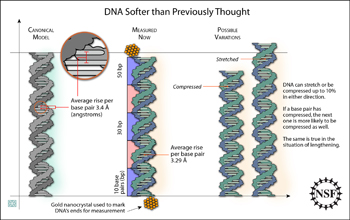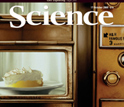|

Press Release 08-184
More Spring in the Double Helix's Step

DNA proven softer than previously thought
October 16, 2008
The DNA's double helix--the sub-microscopic core of our life--has been the subject of intense study and scrutiny for decades. Observations and measurements at the scale of DNA are tricky. The distance between the rungs in DNA's ladder (or base pairs), for example, was thought to be barely over 3 millionths of a millimeter, or 3.4 Å (angstroms). And this ladder has been typically assumed to be very rigid. But now a team of Stanford scientists, supported in part by the National Science Foundation, have used a novel molecular ruler to cast doubts on this picture. Using this molecular ruler, they marked each end of a snippet of DNA with electron-dense gold nanocrystals. These markers scattered X-rays directed at the sample differently than the rest of the molecules, and allowed for a more precise calculation. The observations led the Stanford team to discover that DNA is much softer than previously thought. Variation--both compression and stretching--was observed. Most surprisingly, the team found that if a base pair had compressed, the base pairs in at least the next two turns of the double helix were more likely to be compressed as well. These observations have important ramifications for biologists looking at proteins binding to DNA, such as transcription factors regulating gene expression. Because this study has shown regions of DNA affecting the behavior of neighboring regions, it could mean that proteins binding to the DNA could communicate across greater molecular distances than previously thought.
-NSF-

Media Contacts
Lily Whiteman, National Science Foundation (703) 292-8310 lwhitema@nsf.gov
Michelle Brandt, Stanford University School of Medicine (650) 723-0272 mbrandt@stanford.edu
Program Contacts
William J. Hahn, National Science Foundation (703) 292-8545 whahn@nsf.gov
Principal Investigators
Pehr Harbury, Stanford University School of Medicine (650) 723-6161 harbury@cmgm.standford.edu

The National Science Foundation (NSF) is an independent federal agency that
supports fundamental research and education across all fields of science and
engineering, with an annual budget of $6.06 billion. NSF funds reach all 50
states through grants to over 1,900 universities and institutions. Each year,
NSF receives about 45,000 competitive requests for funding, and makes over
11,500 new funding awards. NSF also awards over $400 million in
professional and service contracts yearly.
 Get News Updates by Email Get News Updates by Email
Useful NSF Web Sites:
NSF Home Page: http://www.nsf.gov
NSF News: http://www.nsf.gov/news/
For the News Media: http://www.nsf.gov/news/newsroom.jsp
Science and Engineering Statistics: http://www.nsf.gov/statistics/
Awards Searches: http://www.nsf.gov/awardsearch/
| 


